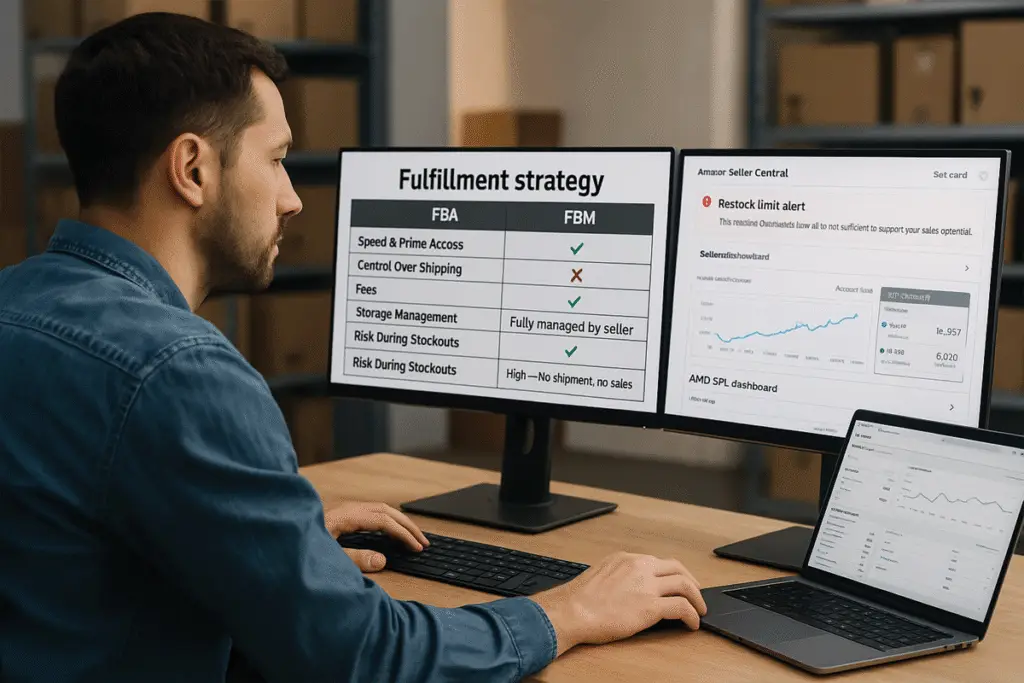Optimizing Fulfillment Strategies Amid Amazon Logistics Changes in 2025

In 2025, Amazon continues to revise its fulfillment policies — including restock limits, warehouse prioritization, and delivery standards. For sellers, these changes mean relying on Fulfillment by Amazon (FBA) alone is no longer enough. Smart sellers are diversifying their operations and optimizing every step of their Amazon fulfillment strategy to stay competitive.
In this post, we’ll discuss how to respond to Amazon’s logistics updates, compare FBA vs. FBM in 2025, and share seller-tested tactics to improve inventory management and delivery performance.
Amazon’s Recent Fulfillment Policy Changes
Here’s what’s shifting in 2025:
Stricter restock limits based on sell-through rates and account health
Higher storage fees for slow-moving inventory
More ASIN-level restrictions, not just account-level
Faster delivery standards are required to win the Buy Box
Priority access to Amazon Warehousing & Distribution (AWD) for top-performing sellers
If you don’t adjust your fulfillment strategy, you could see stockouts, storage penalties, or loss of Buy Box share.
FBA vs. FBM in 2025: What’s the Better Option?
| Feature | FBA | FBM |
|---|---|---|
| Speed & Prime Access | ✅ 1–2 day Prime shipping | ❌ No Prime badge (unless SFP) |
| Control Over Shipping | ❌ Amazon handles everything | ✅ Seller has full control |
| Fees | Medium–High | Lower per order, but higher effort |
| Storage Management | Restricted by IPI and restock | Fully managed by the seller |
| Risk During Stockouts | High — No shipment, no sales | Medium — Seller can reroute |
Our recommendation:
Use FBA for fast-moving ASINs with predictable volume.
Use FBM for low-volume or oversized items to reduce fees and storage risk.
Fulfillment Strategies to Stay Ahead in 2025
1. Track IPI Score and Sell-Through Rates Weekly
Keep IPI above 400 to avoid storage limits
Remove dead inventory every 30 days
Bundle slower-moving products to increase sell-through
2. Use 3PLs as Backup Fulfillment Partners
Don’t rely on Amazon as your only warehouse. A reputable third-party logistics (3PL) partner helps you:
Fulfill FBM orders faster
Shift inventory during Q4 limits
Stay operational during warehouse blackouts or carrier delays
3. Enroll in Amazon Warehousing and Distribution (AWD)
AWD now offers:
Low-cost bulk storage
Direct-to-consumer fulfillment
Inventory movement between warehouses
But approval is invite-only or based on past FBA performance. Keep your AHR and IPI healthy to gain access.
4. Optimize Inventory Forecasting
Amazon penalizes overstocking, and out-of-stock listings lose rank fast. Use tools like:
Restock recommendations in Seller Central
Helium 10 or Forecastly for advanced projections
Weekly lead time reviews with suppliers
5. Consider SFP (Seller Fulfilled Prime) If You Can Meet Requirements
Seller Fulfilled Prime is back — but the bar is higher:
1–2 day delivery
Weekend pickups
Nationwide coverage
If you have warehouse capacity and consistent carrier support, SFP lets you compete with FBA on delivery speed while maintaining full control.
Amazon Sellers Can Still Dominate FBA
Your Amazon fulfillment strategy in 2025 needs to be flexible, diversified, and data-driven. FBA is still powerful, but it’s no longer one-size-fits-all. Top sellers are mixing in FBM, third-party partners, and AWD to keep shelves stocked and customers happy.
If your listings are impacted by restock limits, Buy Box loss, or fulfillment-related suspensions, contact Amazon Sellers Lawyer for a case review.
For ongoing protection of your brand, pricing, and distribution network, visit Brand Enforcement Law.
